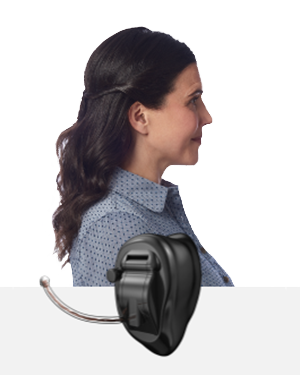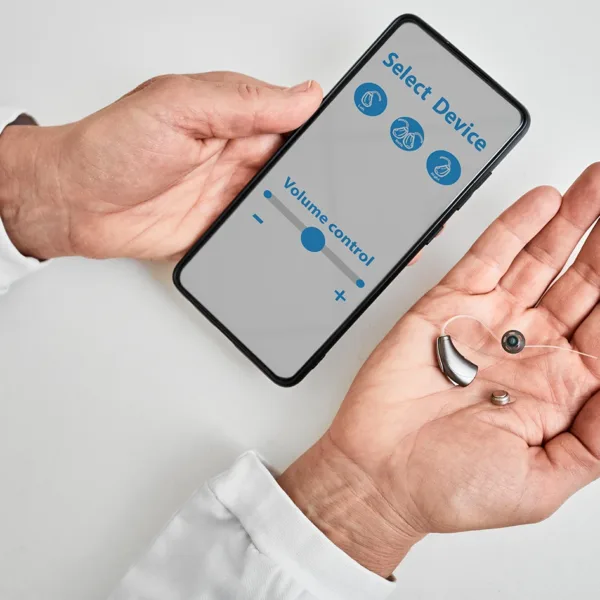
Hearing aids are an essential and life-changing tool for anyone with hearing loss. However, with so many types of hearing aids available, it can be overwhelming to choose the right one. Hearing aids come in a variety of shapes, sizes, and styles, each designed to offer specific features to cater to different levels of hearing loss and individual preferences. The differences between in-the-ear and over-the-ear hearing aids are among the most significant considerations when choosing the best hearing aid for your needs.
Choosing the best hearing aid for you will depend on a number of factors, including your level of hearing loss, your lifestyle, aesthetic concerns, required features, and more. To ensure you receive the best treatment option for your needs, it’s best to consult a hearing healthcare specialist.
In this article, we will address the key differences between in-the-ear and over-the-ear hearing aids, including the various design styles, available features, care requirements, and more.
In-the-ear Hearing Aids for Mild to Severe Hearing Loss
In-the-ear (ITE) hearing aids are made to fit individual ears and are available in a variety of different styles, ranging from smaller and more discreet to slightly larger devices that offer more advanced functionality. They are custom fitted to your ear for maximum comfort and effectiveness. While not suitable for individuals with profound hearing loss, ITE hearing aids can treat a varying degree of hearing loss ranging from mild to moderate, and in some cases, severe.
The following is an overview of the most popular in-the-ear hearing aid styles listed from largest to smallest.
In-the-ear (ITE) Hearing Aids

In-the-ear hearing aids are custom molded to fit comfortably inside the outer ear and can effectively treat mild to severe degrees of hearing loss. ITE hearing aids are the largest of all the styles of custom devices and can accommodate more advanced volume and microphone controls than some of the smaller styles.
In-the-canal (ITC) Hearing Aids

In-the-canal devices are the second largest style of hearing aid worn in the ear. They are custom molded to fit within the canal with a very small portion of the device visible in the outer ear. ITC hearing aids are suitable for people with mild to moderate degrees of hearing loss. While smaller than an ITE, many in-the-canal hearing aids can also accommodate more advanced volume and microphone controls.
Completely-in-the-canal (CIC) Hearing Aids

Completely-in-the-canal hearing aids are custom molded to fit completely inside the ear canal with only a tiny removal handle visible while being worn. CIC hearing aids are suitable for people with mild to moderate degrees of hearing loss. Due to their closed-fit design, CIC devices are much less likely to interfere with daily activities like using the phone, and they are also much less prone to wind interference, and feedback. However, the small design of CIC hearing aids does limit certain features like microphone controls and battery life expectancy.
Invisible-in-the-canal (IIC) Hearing Aids

Invisible-in-the-canal hearing aids are the smallest and most discreet style of custom ITE devices and worn completely inside the ear canal, where no one can see them. IIC aids are a great option for patients with mild to moderate degrees of hearing loss. They are easy to wear and will not interfere with daily activities like using the phone, and wearers do not need to worry about wind interference, or feedback issues. However, due to their small size and deep fit within the ear canal, microphone controls are not available, and battery life expectancy is lower than with the ITE and ITC devices.
Over-the-ear Hearing Aids for Mild to Profound Hearing Loss
Over-the-Ear hearing aids are the most widely used devices due to their versatility. They are designed to accommodate more advanced degrees of hearing loss than custom ITE hearing aids, ranging from mild all the way to profound. Due to their larger size, they can house more advanced hearing technology, additional features, and have a longer battery life than most ITE aids.
The following is an overview of the standard hearing aid styles worn over the ear.
Behind-the-ear (BTE) Hearing Aids

Behind-the-ear devices are the only type of hearing aid that can address every degree of hearing loss from mild to profound. They are designed with a durable plastic casing that rests behind the ear. The only thing that goes into the ear is either a tube or wire with a soft tip, or a custom-made ear mold, depending on the fitting, which is fitted into the outer ear canal.
Feedback and wind interference with BTE hearing aids are possible but should not be a common issue.
Receiver-in-canal (RIC) Hearing Aids

Receiver-in-the-canal hearing aids can treat mild to severe levels of hearing loss and are typically smaller than traditional behind-the-ear (BTE) models. RIC devices have an almost invisible wire connecting an exterior case to a tiny earbud that is comfortably inserted into the ear canal. This internal speaker design offers a more subtle look, which is often favored by hearing aid wearers.
RIC hearing aids are simple to insert and can support most hearing technologies. Like BTE devices, feedback and wind interference are possible, but should not be a common issue.
In-the-ear Hearing Aids vs Over-the-ear Hearing Aids
When it comes to comparing in-the-ear hearing aids and over-the-ear hearing aids, size and level of hearing loss are two of the most obvious differences. However, if your degree of hearing loss is less than severe, and you have the option of choosing between ITE and OTE devices, here are some of key factors to consider.
Comfort
The comfort of custom ITE hearing aids vs OTE hearing aids will vary from person to person. Devices worn In-the-ear are custom fitted to sit snugly in the ear canal, providing more comfort for some wearers. While over-the-ear hearing aids are larger, they are engineered to be very light, and comfortable to wear for long periods of time. However, standard over-the-ear styles may still be less comfortable for some users, especially those who wear glasses, hats, or facemasks regularly.
Aesthetics
When it comes to aesthetics, most people want their hearing aids to be as discreet as possible. With rapid advances in hearing technology, hearing aids of every type are getting smaller and smaller, while still providing excellent benefits and robust functionality. This means that both custom-made in-the-ear devices and standard over-the-ear devices are available in smaller, less noticeable styles and designs.
Maintenance
Cleaning and maintaining your hearing aids is very important to the life of the device. Wax and debris have the potential to interfere with the sound quality of the aid, so no matter the style of hearing aid you wear, it’s important that you clean them regularly. Because all hearing aids have a portion that fits inside the ear canal to deliver sound, they can be subject to wax build up and moisture from the ear. Wax and moisture can cause damage to hearing aids, so it’s very important to clean them daily, and have a conversation with your hearing healthcare professional about how and when to change your wax guards at home.
How to Change Your Hearing Aid Wax Guard
In-the-Ear Hearing Aids
Behind-the-Ear Hearing Aids
Batteries
The larger the hearing aid, the larger the battery it can accommodate, which is why in general, standard over-the-ear aids have longer battery life compared to some custom (CIC and IIC) devices. Today, standard hearing aids and even custom aids are both available in rechargeable battery options as well! You can expect standard hearing aid batteries to last anywhere from 3 days up to 10 days, but several factors can affect their lifespan, including the type and capacity of the battery, the amount and type of usage, as well as the specific type of hearing aid being used.
How to Replace Your Hearing Aid Batteries
In-the-Ear Hearing Aids
Behind-the-Ear Hearing Aids
Find the Best Hearing Aid for You at Audibel
When it comes to taking control of your hearing health, one of the biggest and most rewarding decisions you can make is to address your hearing loss with hearing aids. ITE hearing aids are a great option for patients with mild to moderate or severe hearing loss looking for a custom-fit solution that is discreet as possible. OTE hearing aids are larger and more powerful, making them ideal for patients with any level of hearing loss including profound.
At Audibel, your hearing health is our primary concern, and we want to help you find the best hearing aid for your unique needs. We encourage you to take the first step to finding the personalized hearing healthcare you deserve by scheduling an appointment at any of our hearing clinics located throughout the United States.







Have a question or Comment?